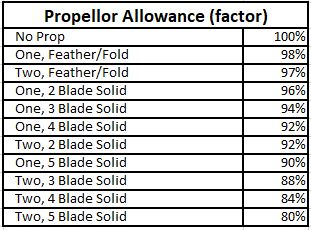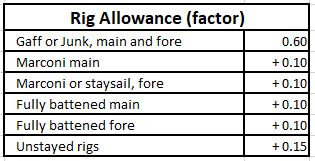Entry is open to all schooner-rigged vessels. Traditional non-schooner rigged vessels may apply to race in Class N. The race committee will evaluate applications and invite the vessels as appropriate. They reserve the right to reject entries for any reasons.
2021 Handicapping Formula
The GCBSR uses a rating factor handicapping (also known as time on time) method for calculating the corrected time for each vessel. Boats of similar rating factor should perform similarly. The corrected time is calculated:
Corrected Time = Actual Elapsed Time * Rating factor
where the rating factor is calculated:
Rating Factor = √Rated Length / √40
finally the rated length is based on the 1974 Off Soundings Club Rating Rule:
Rated Length=[ {L + (2 * √MSA * RA)} / 2.5 ]*PA
where L=PL +/- BC
PL=( LOA + LWL ) / 2
BC=2 * ( LOA / 4 – beam )
MSA=Measured sail area
PA=Propeller Allowance
RA=Rig Allowance
The critical elements of this formula are the boat’s dimensions, sail area, prop and rig type. Measured Sail Area is the theoretical area available for lowers, and reflects the rig type and size, not the boat’s sail inventory. There is no provision for spinnakers, topsails, etc. so boats carrying these sails have some initial advantage.


Because the rating factor based on rated length is only a first approximation of the boat’s performance, the rating factor is then further adjusted each year based on the cumulative performance of the vessel vis-à-vis the rest of the racing fleet in all previous races. Statistical methods are used to develop an accurate handicap for each vessel. The Rating Factor has been calculated for every boat that has participated in the Race since 1999.
Vessels with larger Rating Factors will wind up “owing time” to vessels with a lower Rating factor. The list of 2021 Rating Factors for all schooners that have raced in the past 20 years can be found here. If you want to read more about the handicapping method, read Why and How.
Fleet and Classes
The handicapping method used allows any two boats to be meaningfully raced against each other, however, there is a desire among the GCBSR fleet to race similar types of boats against each other. Therefore, classes are established based on rig and vessel size. Classes have changed over the years, as has the course length for each class. This year’s classes will be:
AA: Invitational Class: Traditional, larger vessels
A: Larger or more modern vessels (rated length 40ft or greater)
B: Mid-size vessels (rated length between 35 – 40ft)
C: Smaller vessels (rated length below 35ft)
N: Invitational Class: Non-Schooner vessels (traditional vessels with a mission that aligns with the GCBSR’s)
The dividing length between larger and smaller may be adjusted year by year to balance the size of the classes. The criteria that define a vessel as more modern are the same as those used to adjust the handicapping for the race: unstayed rigs, fully-battened sails, and marconi or staysail foresail rigs.
There are two fleets that race in the GCBSR:
Thimble Shoal Fleet (~119 nm course)
Class AA and Class A
Windmill Point Fleet (~84 nm course)
Class B and Class C
Cove Point Fleet (~35nm course)
Class N
The race committee reserves the right to make appropriate adjustments in rating factor or class placement until the vessel becomes competitive. The first time a schooner competes, she normally races without adjustment. The vessel’s previous performance will be used to adjust the vessel’s rating. If you feel you have reason to question your rating, please review the issue with the race committee.
An Important Note on Handicapping
The Great Chesapeake Bay Schooner Race is a race meant for the fun of getting together a group of classic sailing vessels and participating in a fun race down the Bay. No large value prizes or sailing careers are on the line. A significant effort has been made to attempt to provide a handicapping method that can allow vessels of wildly different types, age and construction to race against each other. That said, there is no such thing as a perfect handicapping system, and nobody should read too much into which vessels place in any class.

